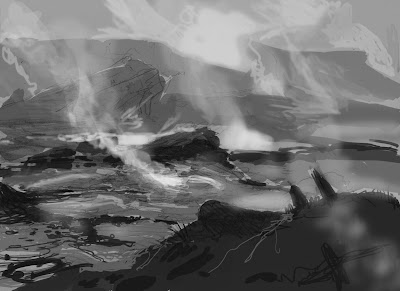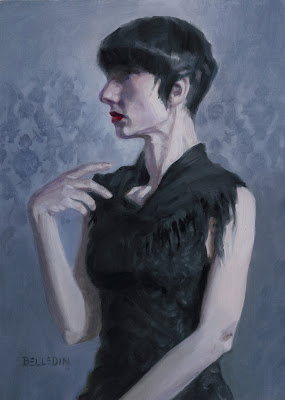Moving across a continent, it turns out, is a difficult thing. Though I've not completed the task as yet, I'm at least deep enough into the process that I can safely tell you that I'd do things differently if I had to do it all again in the future. If there is a next time (and there won't be), I'd likely just pile my worldly belongings in the front yard and set it all on fire. Then I'd be free to move with ease and have the ability to start from scratch at our final destination. Fortunately, despite the inherent stresses of this particular move, Amy and I have somehow managed to keep our cool.
Mostly.
The issues we have had were mostly due to timing. First off, while Amy's new job was the stuff of dreams, it carried with it a need to be in Seattle very shortly after accepting the position. As a result, we were left with just enough time to once more sort through our worldly belongings (which after several previous moves had been thoroughly picked through), make several trips to the local donation bins, and for me to get a couple days of painting done on an assignment that I'd already committed to before the job offer even came along.
What we didn't have time for was the little things like getting our stuff packed up and moved out to Seattle. However, even if we had the time to get all that squared away, we'd have had no address to give the movers as we didn't have a new apartment lined up. And so the moving dates got kicked down the road to relatively arbitrary dates which would hopefully result in our stuff arriving in Seattle on or about August 1st. In the meantime, we would temporarily relocate to Seattle with whatever would fit in two suitcases (mine was mostly art supplies), with the mission to find a new place while Amy began her new job.
Having gone through a couple moves in the last three years, we thought we were pretty prepared — in fact, Amy managed to get most of the ducks in a row. And though it seemed as though we were on top of things, it turned out that what we simply were not prepared for was the rental housing market in Seattle. Previous experiences in shopping for a place to live in the Boston and greater New York Metro areas yielded multiple viable options in very short periods of time. This was not to be so in the Emerald City.
Initially, we did what we'd done before: call some realtors. Unlike in previous cases, realtors turned out not to be particularly helpful. Not only did the realtors rarely get back to us, but it turned out they were actually an obstacle to finding a place to live. Why? Simple. Involving them lost precious time in reacting to opportunities. This is extremely important in the current rental climate because apartments and houses are being snatched up within minutes of being listed. Several times we arrived to see properties that had been listed a mere day before only to be presented with stacks of completed applications from other potential renters. Other times we dealt with the gauntlet of open houses for rental properties where dozens of people were crowded into spaces not fit to hold them as they all vied for a chance to live in the place.
The net result of the extreme competition in the current rental market in Seattle is that the easiest places to get to see were the places that most folks would not want to live in. Places that smelled of cat urine or wet dog. Apartments completely devoid of light. Houses with mother-in-law suites where the mother-in-law just might be stuffed into the crawl space or boarded up behind one of the walls. Places completely wrecked by previous tenants or kept by seemingly indifferent landlords. And then there were the many decent dwellings that were in less than optimal neighborhoods.
For the most part, visiting many of these places was like being thrown into a pit to fight it out with other potential renters. While some of property owners were likely just attempting to ferret out bad candidates, I'm certain that many of the tactics involved were attempts to start bidding wars. Either way, we figured that you could tell a lot about potential landlords by how they treated their potential renters. Folks that created situations that encouraged passive aggressive behavior or open hostility between strangers were not the kind of folks we wanted to write checks to every month. It's no surprise, either, that there turned out to be a correlation between the level of class displayed by landlords when dealing with potential renters and the quality of the dwellings themselves.
To say that our first few days searching here were disheartening would be an understatement. While I attempted to stay optimistic about it all (something that is quite out of character), Amy began to have her doubts and I could tell she was starting to get a little stressed. Nevertheless, each morning we got up early and went through the listings, making phone call after phone call, just hoping for a place to come along that we could snatch up and make our own.
I'm happy to say that after many days of searching, we finally did find a place with promise. Within five minutes of the house being listed, Amy had already sent an email. Not long after, we got a call to come look at the place. A tour was given, an application was filled out, some references were checked, and the place was ours.
There was much rejoicing.
Now, I realize that I've made it sound as though we've done all this ourselves. The truth is that we've had a lot of assistance. Amy's new employer has been incredibly helpful in trying to smooth out the logistics of
relocating cross-country. They've answered a lot of questions and have
bent over backwards to make the compressed timeline easier to deal with.
Our biggest thanks, however, have to go to Franz and Imelda Vohwinkel
who have given generously of their time to help us find a place, advise
us on neighborhoods, and send us more listings than we could count.
Their aid was key to our finding our new home and I simply cannot thank
them enough. A new place to live was easily the biggest variable we had to solve for and was probably the most stressful.
Securing an apartment here in Seattle meant that the remaining big puzzle pieces were finally ready to be put into place, and for the most part we've managed to get everything figured out. Next week, we'll return to New Jersey, pack a few things, close up shop, and supervise the move. Then we'll fly back here and wait for everything to show up. And while waiting in some ways will be the most difficult part of this process, I must confess it'll also somehow be the least stressful. There will be no decisions to make after all, and at least I'll be able to do some prep work at the new place to bide my time.
The end of this journey may not be in sight, but I'm happy to say we've got a pretty good map to help us get there.




























